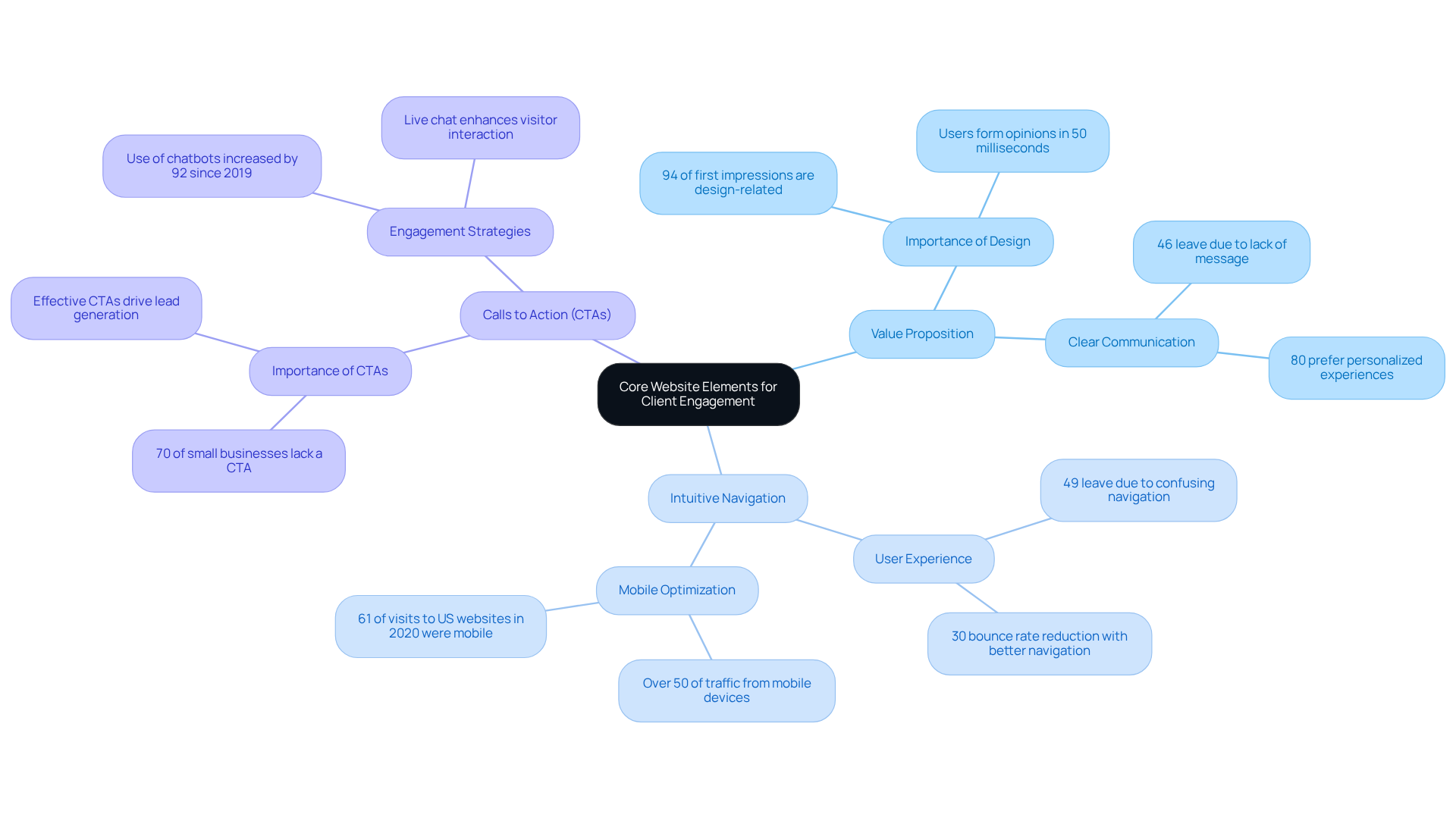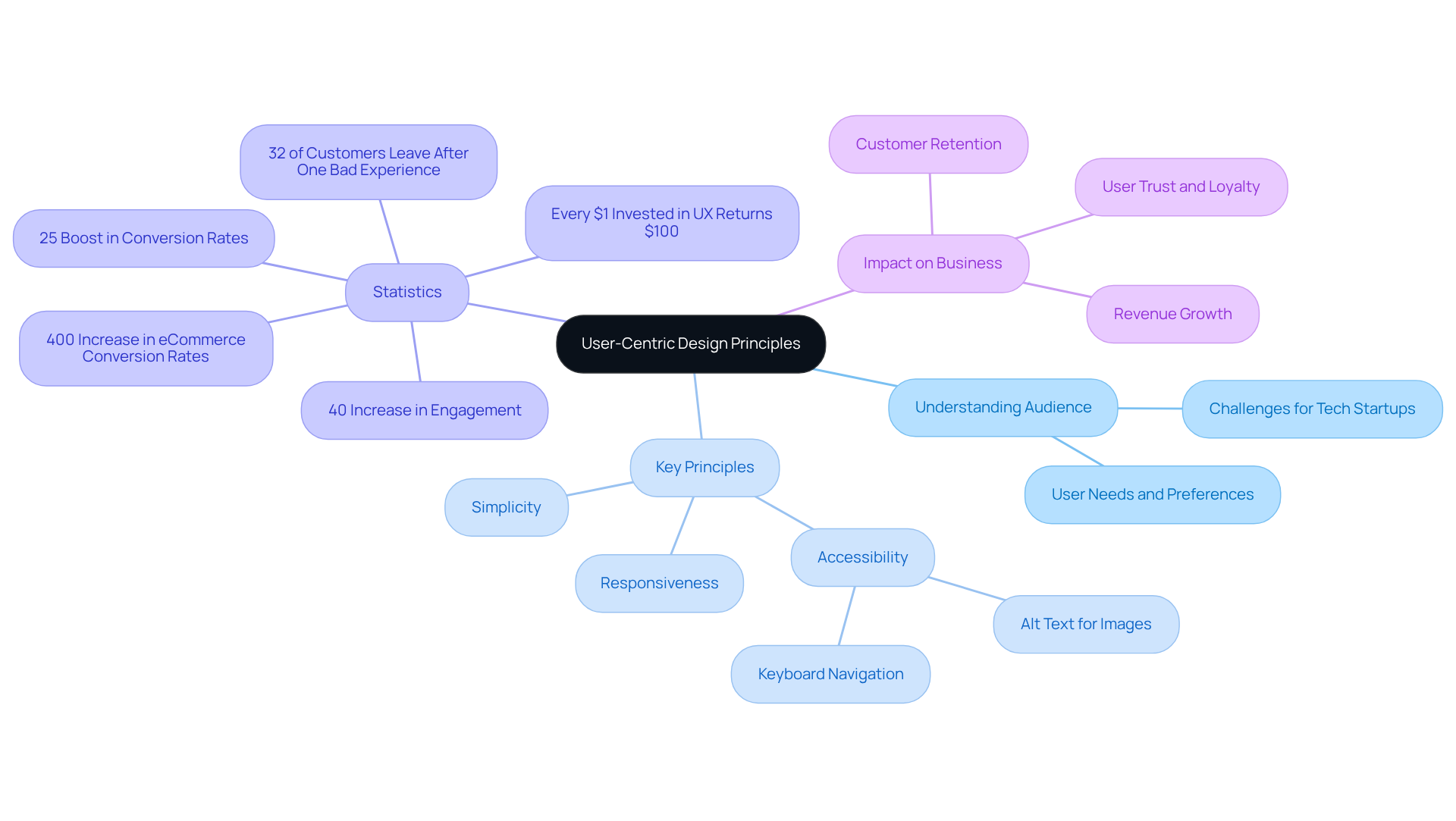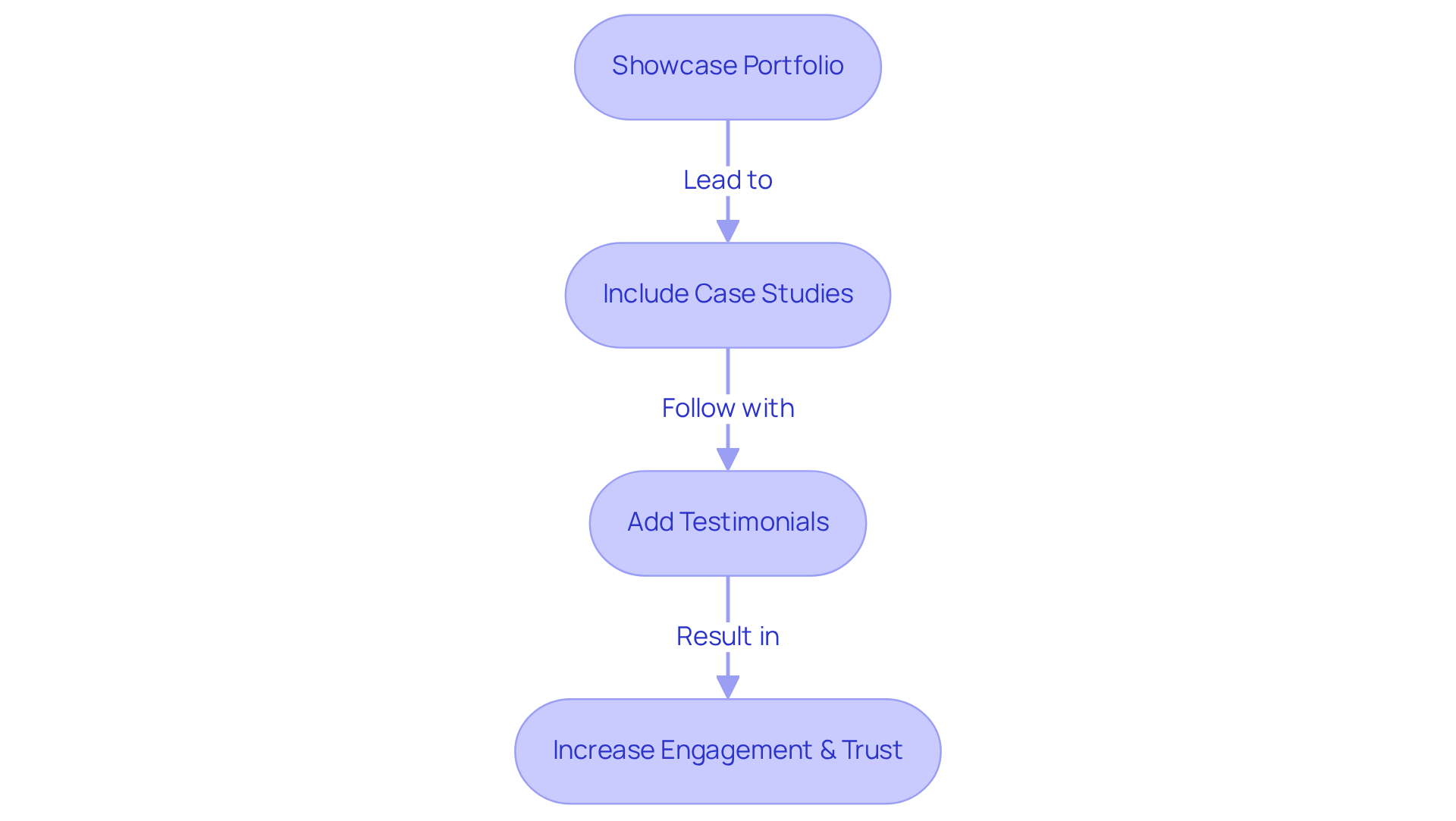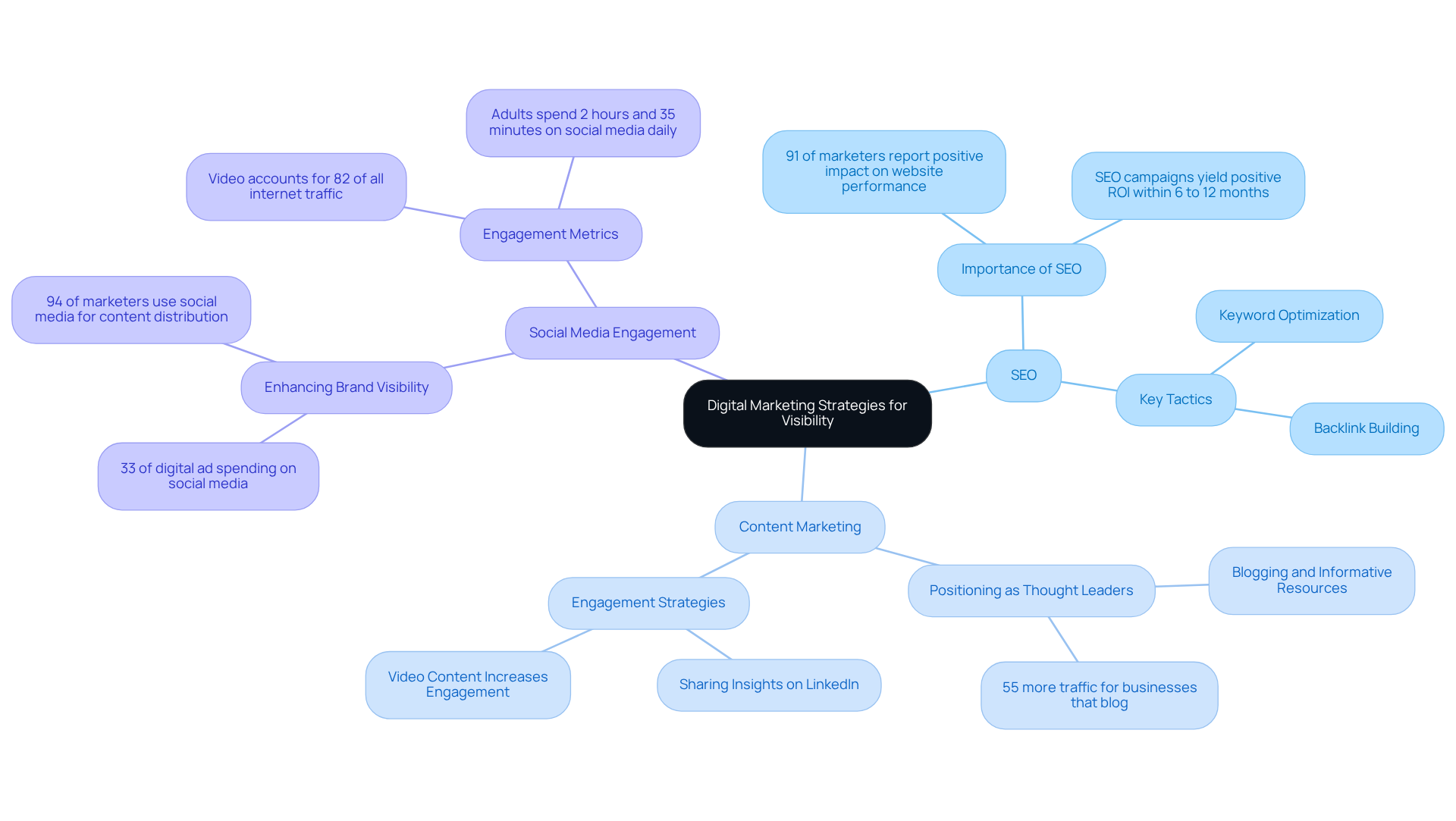Overview
In today's digital landscape, many agencies struggle to effectively engage their clients through their websites. This challenge can lead to missed opportunities for growth and connection. However, there are ways to transform this experience into a positive journey.
The article highlights four best practices that can significantly enhance an agency's website for growth. These practices focus on essential elements such as:
- Fostering client engagement
- Embracing user-centric design
- Showcasing success stories
- Leveraging digital marketing strategies
Supported by compelling statistics and case studies, these practices demonstrate their effectiveness in improving user interaction, increasing conversion rates, and enhancing overall visibility. By implementing these strategies, agencies can create a nurturing online environment that fosters growth and builds lasting relationships with their clients.
Introduction
In today's fast-paced digital landscape, agencies are confronted with the pressing need to adapt in order to remain relevant and competitive. This can feel overwhelming, as the stakes are high. A well-optimized website is not just a digital presence; it is the cornerstone for growth. It serves as a vital platform for showcasing services and, more importantly, as a means to engage clients effectively.
Yet, many agencies find themselves grappling with the challenge of transforming their online presence into a powerful tool for client interaction and visibility. This struggle can lead to feelings of frustration and uncertainty.
So, what can be done? What are the best practices that can elevate an agency's website, ensuring it resonates with potential clients and drives sustainable growth? Together, let’s explore how to turn these challenges into opportunities for meaningful connection and growth.
Define Core Website Elements for Client Engagement
Improving customer interaction is a challenge that many firms face, and it’s essential to focus on key website components. A clear value proposition, intuitive navigation, and persuasive calls to action (CTAs) are vital for the agency's website. A well-articulated value proposition on your agency's website not only conveys what your agency offers but also highlights its importance to prospective clients, creating a lasting first impression. Did you know that 94% of individuals base their initial opinions on design? This statistic underscores the significance of getting it right from the start.
At RNO1, we believe in a results-driven approach that ensures these elements are not only aesthetically pleasing but also strategically aligned to deliver measurable success through collaborative strategies. Intuitive navigation plays a crucial role; it allows users to find information effortlessly, which can reduce bounce rates by up to 30% and significantly increase conversion rates. Unfortunately, 49% of users leave online platforms due to confusing navigation, which highlights the need for .
Additionally, it's concerning that 70% of small businesses lack a CTA on their homepage, pointing to a frequent oversight that agencies can address. Effective CTAs, such as a prominently displayed 'Get a Quote' button on the agency's website, can drive lead generation and enhance visitor interaction. Moreover, incorporating live chat functionalities can provide instant support, and it's noteworthy that the utilization of website chatbots has risen by 92% since 2019, further improving engagement and satisfaction.
By focusing on these core elements and adopting a collaborative strategy, RNO1 can help create a more effective online presence that resonates with clients and fosters growth. We invite you to share your experiences and thoughts on this journey together.

Implement User-Centric Design Principles
Understanding the needs and preferences of your target audience is a challenge that many tech startup founders face. Implementing user-centric design principles is essential to address this issue effectively. Through research techniques such as surveys and usability testing, you can gain valuable insights. Key principles like simplicity, accessibility, and responsiveness are vital. An organized design featuring distinct visual hierarchies promotes easy navigation, ensuring that everyone, including individuals with disabilities, can interact with your content. Accessibility options, such as alt text for images and keyboard navigation, are crucial in this regard. Moreover, with mobile devices accounting for over 54% of global internet traffic in recent years, responsive design has become a necessity to ensure optimal performance across various devices.
At RNO1, we exemplify a commitment to user-centric design through transformative partnerships, helping brands like RentMethod and Spring Labs achieve significant growth. For instance, a technology startup that revamped its online platform with a focus on customer-centric principles reported a remarkable 40% increase in engagement and a 25% boost in conversion rates. This situation highlights how can lead to substantial enhancements in online performance and client satisfaction. Furthermore, strong UX can increase eCommerce conversion rates by up to 400%, showcasing the potential impact of effective design.
It's important to recognize that 32% of customers would leave a brand they loved after just one bad experience, underscoring the necessity of maintaining a positive user experience. Investing in UX is not merely beneficial; every $1 invested in UX returns $100, equating to a staggering return of 9,900%. This makes it a critical focus for tech startups aiming for growth. We understand the journey can be daunting, but with the right support and commitment to user-centric design, you can create meaningful connections with your audience and foster lasting success.

Showcase Portfolio and Client Success Stories
Agencies often face the challenge of effectively showcasing their portfolio and success stories on their platforms. This absence can leave potential customers feeling uncertain about whom to trust. Imagine a startup founder, eager to find the right partner, scrolling through countless options without clear indicators of expertise. This is where the importance of and providing vital social proof comes into play.
Each case study should resonate with the reader, expressing the customer's challenges, the innovative solutions crafted by the firm, and the measurable outcomes achieved. For instance, consider a digital marketing agency that shares a campaign that increased a customer's website traffic by an impressive 150% within just three months. Such narratives not only inform but also inspire confidence.
Testimonials from satisfied customers further enhance credibility and trust, creating a nurturing environment for potential clients. A thoughtfully structured portfolio page, enriched with engaging visuals and concise narratives, can significantly elevate user engagement and conversion rates. Research indicates that having at least 50 reviews can boost conversion rates by up to 4.6%, underscoring the power of social proof in guiding consumer choices.
Moreover, organizations that effectively leverage client success stories can witness profound growth, as these narratives establish credibility while connecting with potential clients, demonstrating the tangible benefits of their services. In this journey, RNO1 stands ready to support agencies in crafting these compelling stories, nurturing connections that lead to lasting partnerships.

Leverage Digital Marketing Strategies for Visibility
In today’s competitive landscape, many agencies struggle with visibility on their agency's website, feeling overwhelmed by the sheer volume of content and the complexity of digital marketing. This challenge can lead to frustration, as potential clients may overlook their valuable services. It’s essential to understand that without a comprehensive strategy, agencies risk fading into the background, unable to showcase their expertise.
To overcome this hurdle, agencies can adopt a nurturing approach on the agency's website that combines (SEO), content marketing, and social media engagement. SEO focuses on enhancing online content with relevant keywords, which is crucial for improving search engine rankings. For example, many marketers have experienced the benefits of SEO, with reports indicating that 91% observed a positive impact on their website performance. Additionally, studies show that SEO campaigns typically yield a positive ROI within 6 to 12 months, highlighting its effectiveness.
Content marketing, through avenues like blogging and creating informative resources, allows organizations to position themselves as thought leaders in their industry while generating organic traffic. By consistently sharing valuable insights on platforms like LinkedIn, agencies can attract potential clients and foster a sense of authority, which can be highlighted on the agency's website.
Moreover, leveraging social media to share content and engage with audiences can significantly enhance brand visibility and promote services effectively. It’s noteworthy that social media accounts for 33% of all digital ad spending, and 94% of marketers utilize these platforms for content distribution. This underscores the vital role social media plays in driving traffic and engagement.
By implementing these strategies, agencies can not only experience increased website traffic but also higher engagement rates and, ultimately, more conversions. Remember, you’re not alone in this journey; by embracing these approaches, you can cultivate a supportive community around your brand and thrive in the digital landscape.

Conclusion
Enhancing an agency's website for growth can feel overwhelming, especially when you're striving to connect with clients in a meaningful way. Many agencies grapple with the challenge of creating an online presence that truly resonates with potential clients. This struggle can lead to missed opportunities for engagement and long-term relationships. However, by prioritizing client engagement, user-centric design, and effective digital marketing strategies, there is a path forward.
Imagine focusing on core website elements like:
- A clear value proposition
- Intuitive navigation
- Compelling calls to action
These foundational aspects can transform your website into a robust platform that fosters genuine connections. It's essential to implement user-centric design principles that cater to your audience's needs and preferences. By conducting thorough research and employing best practices, you can enhance user experience and improve conversion rates.
Additionally, showcasing a well-structured portfolio and client success stories can establish credibility and inspire trust among prospective clients. Think of it as inviting them into your journey, sharing not just what you do, but how you've made a difference for others. Leveraging digital marketing strategies, including SEO and content marketing, will further enhance your visibility and engagement, positioning your agency as a thought leader in your industry.
In conclusion, the journey toward optimizing your agency's website is not just about achieving growth; it's about building a supportive community around your brand. Embracing these best practices can lead to a more profound online presence and meaningful interactions. Remember, the time to act is now—invest in these strategies to unlock the full potential of your agency's website and drive impactful results in an increasingly competitive landscape. Together, we can navigate this journey and cultivate the success you aspire to achieve.
Frequently Asked Questions
What are the key website components essential for client engagement?
The key website components essential for client engagement include a clear value proposition, intuitive navigation, and persuasive calls to action (CTAs).
Why is a well-articulated value proposition important?
A well-articulated value proposition conveys what the agency offers and highlights its importance to prospective clients, creating a lasting first impression.
How does website design impact initial opinions?
According to statistics, 94% of individuals base their initial opinions on design, emphasizing the importance of getting website design right from the start.
What role does intuitive navigation play on a website?
Intuitive navigation allows users to find information effortlessly, which can reduce bounce rates by up to 30% and significantly increase conversion rates.
What percentage of users leave online platforms due to confusing navigation?
49% of users leave online platforms due to confusing navigation, highlighting the need for clarity and simplicity in design.
What common oversight do many small businesses make regarding CTAs?
It is concerning that 70% of small businesses lack a call to action (CTA) on their homepage, which is a frequent oversight that can be addressed.
How can effective CTAs impact lead generation?
Effective CTAs, such as a prominently displayed 'Get a Quote' button, can drive lead generation and enhance visitor interaction.
What additional features can improve website engagement?
Incorporating live chat functionalities can provide instant support, and the utilization of website chatbots has risen by 92% since 2019, further improving engagement and satisfaction.
How can RNO1 help improve an agency's online presence?
RNO1 focuses on core website elements and adopts a collaborative strategy to create a more effective online presence that resonates with clients and fosters growth.




